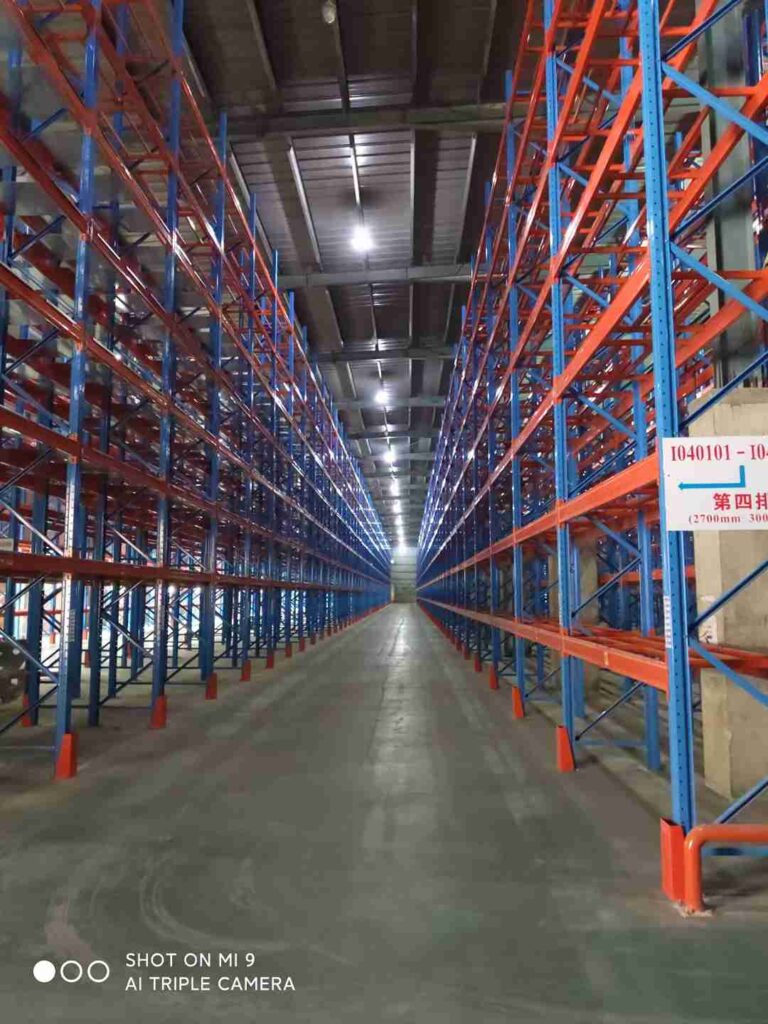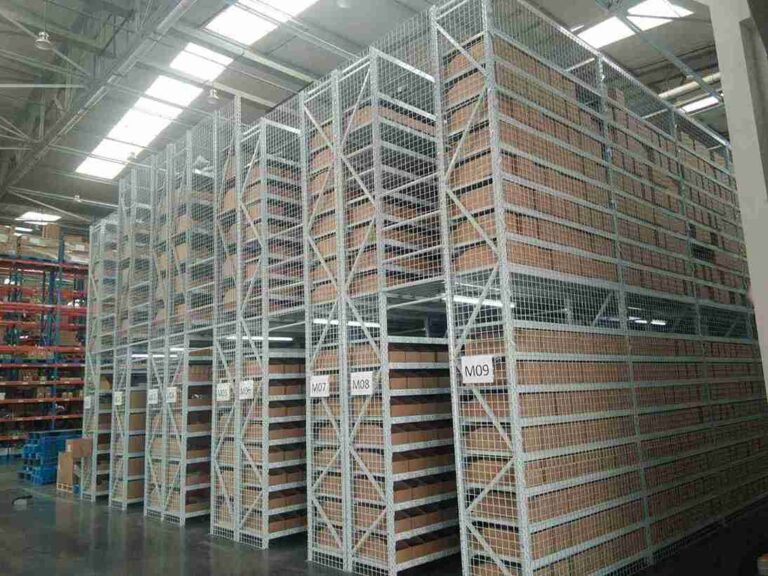📐 "First 50 Enterprise Queries Get Custom 3D Warehouse Design" Plan

Introduction
In an era where every square foot of warehouse space translates to operational costs and efficiency, narrow aisle space utilization has emerged as a game-changing strategy for modern logistics. Businesses struggling with limited storage capacity are increasingly turning to narrow aisle racking systems to maximize warehouse space, streamline workflows, and reduce overhead expenses.
This in-depth guide explores how narrow aisle space utilization revolutionizes storage efficiency, the different types of systems available, best practices for implementation, and real-world success stories. Whether managing a distribution center, e-commerce fulfillment hub, or manufacturing warehouse, optimizing narrow aisle space utilization can lead to higher storage density, faster order picking, and lower operational costs.

What Is Narrow Aisle Space Utilization?
The Science Behind Efficient Storage
Narrow aisle space utilization refers to the strategic reduction of aisle widths in a warehouse while maintaining full accessibility to stored goods. Unlike traditional wide-aisle setups (10-12 feet), narrow aisle racking systems operate within 6-8 feet, allowing businesses to store up to 50% more inventory in the same footprint.
How Narrow Aisle Space Utilization Works
- Reduced Aisle Widths: By shrinking aisles from 12 feet to 6-8 feet, warehouses can increase pallet positions per square foot.
- Specialized Equipment: Forklifts with articulating forks, guided navigation, or wire guidance ensure safe maneuvering in tight spaces.
- Vertical Storage Optimization: Narrow aisle space utilization often pairs with high-bay racking (30+ feet), maximizing cubic storage capacity.
Why Narrow Aisle Space Utilization Is a Must for Modern Warehouses
1. Dramatically Increases Storage Capacity
The primary advantage of narrow aisle space utilization is its ability to store more goods without expanding the warehouse. By minimizing wasted aisle space, businesses can:
- Add 30-50% more pallet positions in the same area.
- Reduce the need for costly facility expansions.
2. Boosts Operational Efficiency
- Shorter Travel Distances: Forklifts spend less time moving between aisles, speeding up order fulfillment.
- Faster Inventory Retrieval: With optimized layouts, workers can access SKUs 20-30% faster than in traditional setups.
3. Lowers Operational Costs
- Reduced Real Estate Costs: Fewer square feet needed per pallet means lower leasing or construction expenses.
- Energy Savings: Smaller aisles require less lighting and HVAC usage, cutting utility bills.
4. Enhances Inventory Accuracy & Control
- Better FIFO (First-In, First-Out) Compliance: Unlike drive-in racking, narrow aisle space utilization allows selective access, reducing stock aging.
- Reduced Picking Errors: Organized layouts minimize misplacements, improving order accuracy.
5. Improves Safety & Longevity
- Reinforced Steel Construction: High-quality narrow aisle racking withstands heavy loads and long-term use.
- Guided Navigation Systems: Minimize forklift collisions, reducing workplace accidents.
Types of Narrow Aisle Racking for Optimal Space Utilization
1. Standard Narrow Aisle Racking (6-8 ft Aisles)
- Uses articulating or stand-up forklifts.
- Ideal for medium-to-high turnover warehouses.
2. Very Narrow Aisle (VNA) Racking (5-6 ft Aisles)
- Requires wire-guided or rail-guided forklifts.
- Best for ultra-high-density storage (e.g., cold storage, automotive parts).
3. Double-Deep Narrow Aisle Racking
- Stores pallets two-deep, further boosting narrow aisle space utilization.
- Requires extended-reach forklifts.
4. Mobile Narrow Aisle Racking (Dynamic Storage)
- Features movable carriages on rails, allowing aisles to shift as needed.
- Perfect for seasonal inventory or space-constrained facilities.
How to Implement Narrow Aisle Space Utilization Successfully
Step 1: Conduct a Warehouse Space Analysis
- Measure current aisle widths, ceiling height, and load capacities.
- Identify high-velocity vs. slow-moving SKUs to optimize placement.
Step 2: Choose the Right Equipment
- Forklift Compatibility: Not all forklifts work in narrow aisles—articulating, reach, or guided trucks are essential.
- Racking Load Capacity: Ensure the system can handle maximum pallet weights.
Step 3: Optimize Layout for Safety & Accessibility
- Install safety barriers, floor markings, and anti-collision sensors.
- Ensure proper lighting and clear signage for operators.
Step 4: Train Staff for Narrow Aisle Operations
- Certified forklift training is mandatory for narrow aisle space utilization.
- Implement strict safety protocols to prevent accidents.
Step 5: Monitor & Continuously Improve
- Use Warehouse Management Systems (WMS) to track efficiency.
- Adjust layouts based on seasonal demand or inventory changes.
Narrow Aisle Space Utilization vs. Other Storage Systems
Comparison with Wide-Aisle Racking
| Feature | Narrow Aisle Racking | Wide-Aisle Racking |
|---|---|---|
| Aisle Width | 6-8 ft | 10-12 ft |
| Storage Density | High (30-50% more pallets) | Low |
| Forklift Type | Specialized (articulating/reach) | Standard |
| Best For | High-turnover, space-constrained warehouses | Low-density storage |
Comparison with Drive-In Racking
- Drive-in racking follows LIFO (Last-In, First-Out), making it poor for perishables.
- Narrow aisle space utilization allows direct access to every pallet (FIFO-friendly).
Overcoming Challenges in Narrow Aisle Space Utilization
1. Higher Initial Investment
- Solution: The long-term ROI (2-5 years) justifies the cost through space savings and efficiency gains.
2. Need for Specialized Forklifts
- Solution: Leasing or financing options can spread out equipment costs.
3. Warehouse Layout Modifications
- Solution: Work with rack engineering experts to ensure structural integrity.
Future Trends in Narrow Aisle Space Utilization
1. Automation & Robotics Integration
- Automated Guided Vehicles (AGVs) and robotic forklifts are making narrow aisle operations even more efficient.
2. Smart Warehousing with IoT & AI
- Real-time rack monitoring via IoT sensors prevents overloading.
- AI-powered slotting optimizes SKU placement for faster picking.
3. Sustainable Warehouse Design
- Energy-efficient LED lighting reduces power consumption in narrow aisles.
- Recyclable racking materials align with green logistics trends.
Conclusion
Narrow aisle space utilization is no longer just an option—it’s a competitive necessity for warehouses aiming to maximize storage, reduce costs, and improve efficiency. By implementing the right narrow aisle racking system, businesses can transform underutilized space into high-density storage zones, ensuring they stay ahead in today’s fast-moving supply chain landscape.
For companies ready to unlock their warehouse’s full potential, consulting with a narrow aisle racking specialist is the next logical step.
Frequently Asked Questions (FAQs)
1. How much can a warehouse save with narrow aisle space utilization?
Businesses typically see 20-40% cost savings from reduced real estate needs and improved operational efficiency.
2. Can narrow aisle racking work in small warehouses?
Absolutely—narrow aisle space utilization is ideal for space-constrained facilities, as it maximizes every square foot.
3. What’s the minimum ceiling height for narrow aisle racking?
While 12-14 ft is standard, systems can be customized for low-clearance warehouses (as low as 8 ft).
4. How long does it take to install a narrow aisle racking system?
Depending on warehouse size, installation typically takes 2-6 weeks.
5. Is narrow aisle space utilization suitable for cold storage?
Yes—narrow aisle racking is widely used in refrigerated warehouses to maximize expensive chilled space.




